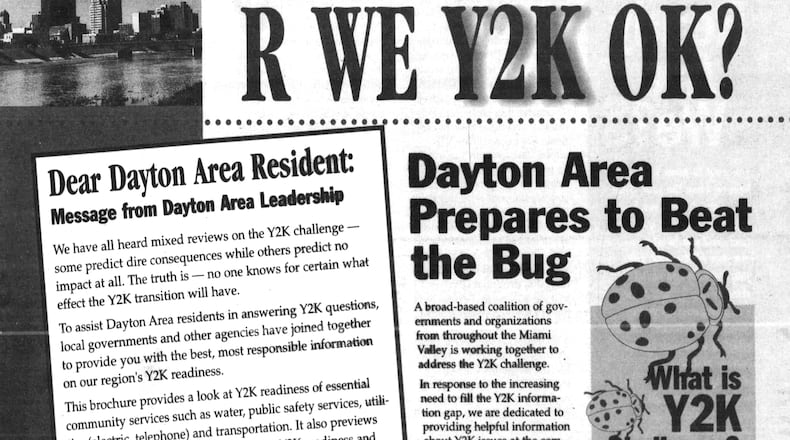The date-related computer problem — years in dates were two characters like “93″ for 1993, but those didn’t accommodate for the 2000 millennium — was expected by some to cause traffic jams, power outages, equipment failures and general mass confusion.
How Dayton prepared
Oakwood City Manger Mike Kelly was president of the Dayton Area City Managers Association at the time of Y2K.
He said at the time that all area cities had participated with the Dayton Area Chamber of Commerce and major industrial entities such as Mead and NCR to compare and exchange notes on Y2K compliance.
“Y2K compliant” was the phrase being used because lawyers for the city said “Y2K ready” implied a guarantee, and they could not guarantee anything.
A Y2K symposium was held at the Dayton Convention Center. Officials from DP&L, Wright-Patterson Air Force Base, the city, county, hospitals, Ameritech and local banks all assured the audience that their equipment was Y2K compliant.
Most cities had extra police and fire staffing and back-up power supplies — just in case.
How Montgomery County prepared
The county’s hardware and software were exhaustively tested before the new millennium.
The county also hired a “disaster recovery service” to maintain copies of all county data, documents and software in case of a major meltdown.
The county was prepared to either bring in “mobile” computer systems or go to another site to keep the county operating.
How Ohio prepared
Gov. Bob Taft and about 300 state workers were conducting extensive planning and preparations for any problems the glitch might bring to Ohio.
To prepare for Y2K, state officials simulated emergencies and practiced using the Ohio Control Room, where four large screens and hundreds of workers could monitor each of Ohio’s 88 counties.
The state spent $130.4 million to upgrade its computers and had 85 workers from 13 agencies on hand at a command center as midnight came.
How households prepared
One of the biggest Y2K problems facing home users was having older software programs on their PC that weren’t created with the year 2000 in mind.
It was a concern that Windows computers would get confused because of the way they displayed dates, such as MM/DD/YY. Users were told to go into their settings and change it to MM/DD/YYYY, so four digits were used to display the year.
While state officials didn’t expect any problems, they still encouraged Ohio families to store enough food, water, batteries and other emergency supplies to last 72 hours.
Schools
Potential Y2K problems caused some school districts and colleges to delay the start of winter classes.
• Dayton Public Schools added five days to Christmas break after New Year’s Day.
• UD and Ohio State delayed the start of winter classes two days.
• Cedarville College postponed their winter term by one day.
• Wright State and Sinclair Community College were among the schools that didn’t make any changes to their scheduled Jan. 3 resumption of classes.
The aftermath
Most experts agreed that all the lights wouldn’t just go out at midnight on Dec. 31. They said it was more likely that the Y2K bug would affect the operation of large systems over the first several weeks or months of 2000.
In the end, there was no computer meltdown in Dayton and officials reported no significant Y2K problems as the new millennium began.
About the Author






